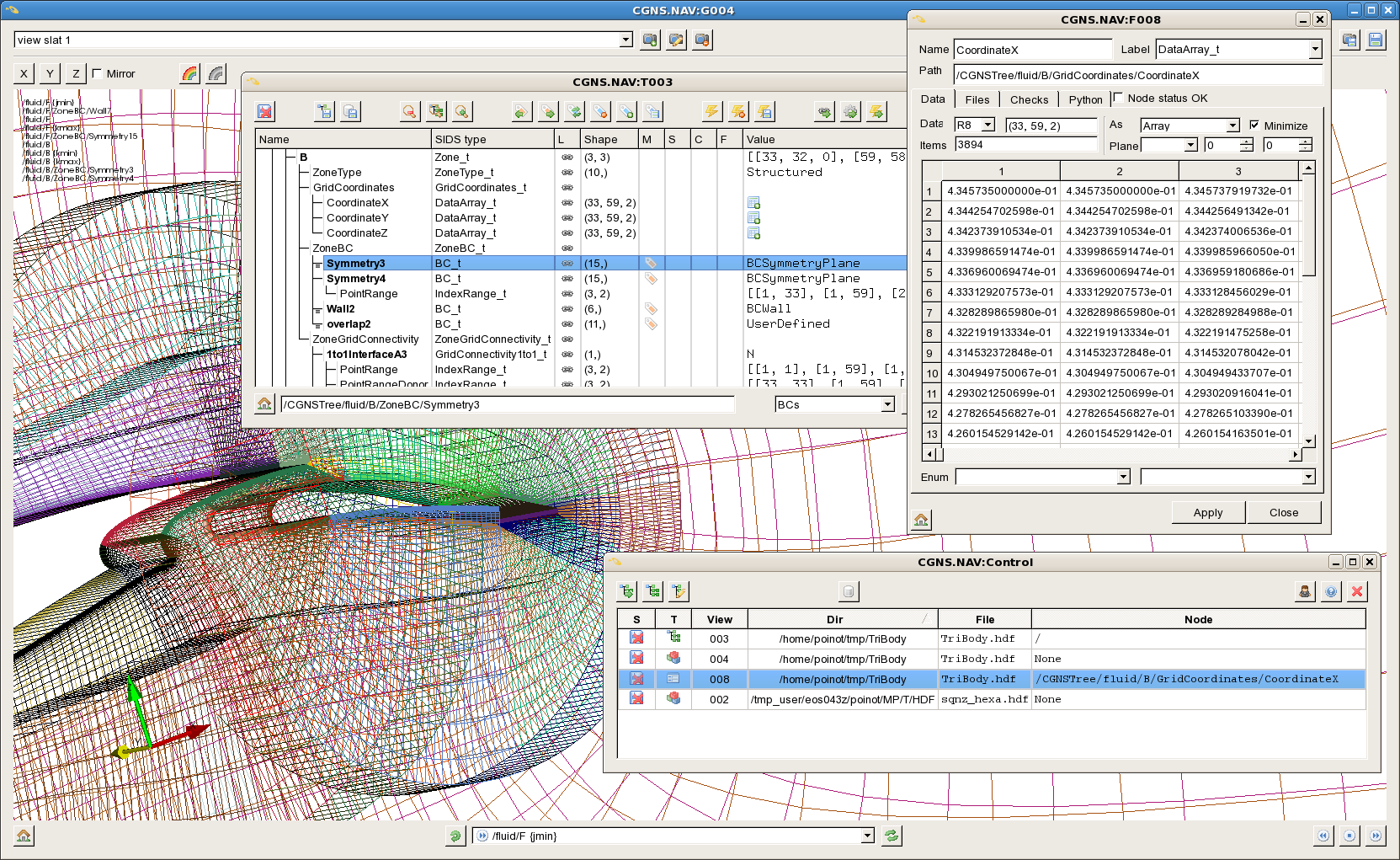About pyCGNS¶
CGNS Standard¶
The purpose of these pages is not to describe the standard. There is the cgns.org web site with a lot of documentation. Anyway, there is a set of How to’s using pyCGNS you can browse and learn a bit about this standard.
Package contents¶
The pyCGNS Python module is a collection of 7 modules around the CGNS standard. Before v4, these modules were independent Python modules with more or less dependancies to each other. We gather all of them to have a common build/install/doc and test process, moreover this insures a better consistency between them.
The pyCGNS module now includes (former package names)
MAP, the Mapper, new in v4 gives basic load/save function from/to CGNS/SIDS and CGNS/HDF5. This very sinple module is able to read/write GCNS/HDF5 files and translate them to CGNS/Python. This is the main feature of pyCGNS v4.0.
PAT, the PatterMaker, a full CGNS/SIDS patterns using the CGNS/Python mapping. This is pure python module, it creates and modify CGNS/Python trees without the help of any HDF5 or even ADf calls.
NAV, the Navigater (was pyS7), a graphical browser that can handle CGNS/Python, CGNS/HDF5 and CGNS/ADF file formats. It is slightly different to cgnsviewer because it actually is a tree editor, you can copy/cut/paste CGNS/Python trees and quickly draft or modify your CGNS tree.
VAL,the Validater (was pyC5), an XML grammar based validation of a CGNS/Python tree, for example produced using MAP or PAT.
DAT, the DataTracer (was pyDAX), some DBMS services for CGNS/HDF5 files. Not maintained anymore in v4.0 (to be resumed 2014/2015)
APP, the ApplicationSampler, a set of applications using other modules.
Quick start¶
Loading a CGNS/HDF file with MAP¶
The CGNS.MAP module implements the CGNS/Python mapping. You can
load/save a CGNS/HDF5 file using the simple MAP functions (below,
the >>> string is the python interpreter prompt):
>>> import CGNS.MAP
>>> (tree,links,paths)=CGNS.MAP.load("./001Disk.hdf")
>>> print tree
['CGNSTree', None, [['CGNSLibraryVersion',array([ 2.4000001],dtype=float32),
[], 'CGNSLibraryVersion_t'], ['Disk', array([3, 3], dtype=int32),
[['.Solver#Command', ... ]
Now tree is a Python list with ./001Disk.hdf CGNS tree
into, with the data structure as described
in SIDS-to-Python.
Using PAT to modify a CGNS tree¶
The previously loaded CGNS/Python tree is modified using plain Python
functions and types. The CGNS.APP module contains utilities, we use the
getNodeByPath function which returns a CGNS/Python node with the
target tree and the target node path as parameters. In the example hereafter,
we are loading a sample tree from the pyCGNS test suite:
import CGNS.PAT.cgnsutils as CGU
import CGNS.PAT.test.disk as data
node=CGU.getNodeByPath(data.T,"/{Base#1}/{Zone-D1}/ZoneGridConnectivity/{CT-D1-D2}")
print node[1]
print node[1].tostring()
The returned node is a list of 4 Python values, the name (a string),
the value of the node (a Numpy array), the list of children and
the CGNS type of the node (string). The returned node of the example is a string
array, you may want to use the tostring function to make it more readable.
Using PAT to create a CGNS tree¶
We want to create a CGNS/HDF5 file with a simple base and a reference state:
import CGNS.PAT.cgnslib as CGL
T=CGL.newCGNSTree()
CGL.newBase(T,'Test Case 01',3,3) # name, physical dim, topological dim
CGL.newSimulationType(T)
CGL.newReferenceState(T)
Each time you call a function you pass the parent node and some parameters.
The tree is built as a python list, the top list is referenced by the T
variable here. As it is passed as argument to each call the new nodes are
added to T into the function. The the resulting T is changed in place.

